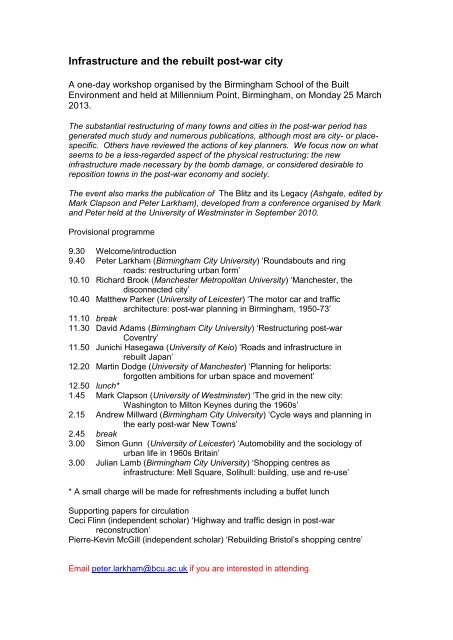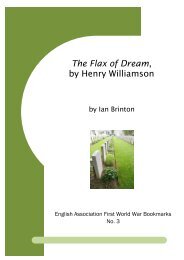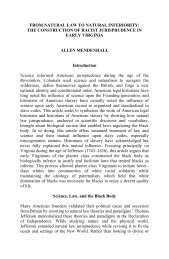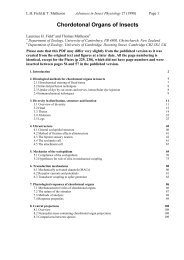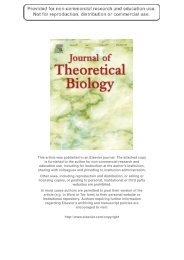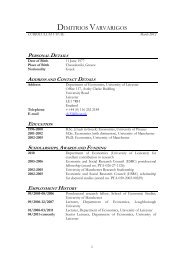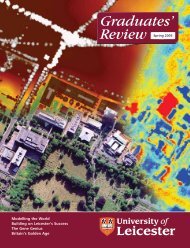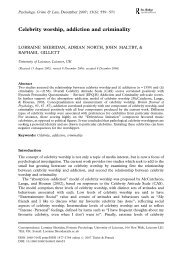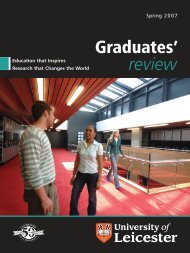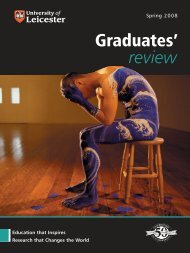Infrastructure and the rebuilt post-war city - University of Leicester
Infrastructure and the rebuilt post-war city - University of Leicester
Infrastructure and the rebuilt post-war city - University of Leicester
Create successful ePaper yourself
Turn your PDF publications into a flip-book with our unique Google optimized e-Paper software.
<strong>Infrastructure</strong> <strong>and</strong> <strong>the</strong> <strong>rebuilt</strong> <strong>post</strong>-<strong>war</strong> <strong>city</strong>A one-day workshop organised by <strong>the</strong> Birmingham School <strong>of</strong> <strong>the</strong> BuiltEnvironment <strong>and</strong> held at Millennium Point, Birmingham, on Monday 25 March2013.The substantial restructuring <strong>of</strong> many towns <strong>and</strong> cities in <strong>the</strong> <strong>post</strong>-<strong>war</strong> period hasgenerated much study <strong>and</strong> numerous publications, although most are <strong>city</strong>- or placespecific.O<strong>the</strong>rs have reviewed <strong>the</strong> actions <strong>of</strong> key planners. We focus now on whatseems to be a less-regarded aspect <strong>of</strong> <strong>the</strong> physical restructuring: <strong>the</strong> newinfrastructure made necessary by <strong>the</strong> bomb damage, or considered desirable toreposition towns in <strong>the</strong> <strong>post</strong>-<strong>war</strong> economy <strong>and</strong> society.The event also marks <strong>the</strong> publication <strong>of</strong> The Blitz <strong>and</strong> its Legacy (Ashgate, edited byMark Clapson <strong>and</strong> Peter Larkham), developed from a conference organised by Mark<strong>and</strong> Peter held at <strong>the</strong> <strong>University</strong> <strong>of</strong> Westminster in September 2010.Provisional programme9.30 Welcome/introduction9.40 Peter Larkham (Birmingham City <strong>University</strong>) ‘Roundabouts <strong>and</strong> ringroads: restructuring urban form’10.10 Richard Brook (Manchester Metropolitan <strong>University</strong>) ‘Manchester, <strong>the</strong>disconnected <strong>city</strong>’10.40 Mat<strong>the</strong>w Parker (<strong>University</strong> <strong>of</strong> <strong>Leicester</strong>) ‘The motor car <strong>and</strong> trafficarchitecture: <strong>post</strong>-<strong>war</strong> planning in Birmingham, 1950-73’11.10 break11.30 David Adams (Birmingham City <strong>University</strong>) ‘Restructuring <strong>post</strong>-<strong>war</strong>Coventry’11.50 Junichi Hasegawa (<strong>University</strong> <strong>of</strong> Keio) ‘Roads <strong>and</strong> infrastructure in<strong>rebuilt</strong> Japan’12.20 Martin Dodge (<strong>University</strong> <strong>of</strong> Manchester) ‘Planning for heliports:forgotten ambitions for urban space <strong>and</strong> movement’12.50 lunch*1.45 Mark Clapson (<strong>University</strong> <strong>of</strong> Westminster) ‘The grid in <strong>the</strong> new <strong>city</strong>:Washington to Milton Keynes during <strong>the</strong> 1960s’2.15 Andrew Mill<strong>war</strong>d (Birmingham City <strong>University</strong>) ‘Cycle ways <strong>and</strong> planning in<strong>the</strong> early <strong>post</strong>-<strong>war</strong> New Towns’2.45 break3.00 Simon Gunn (<strong>University</strong> <strong>of</strong> <strong>Leicester</strong>) ‘Automobility <strong>and</strong> <strong>the</strong> sociology <strong>of</strong>urban life in 1960s Britain’3.00 Julian Lamb (Birmingham City <strong>University</strong>) ‘Shopping centres asinfrastructure: Mell Square, Solihull: building, use <strong>and</strong> re-use’* A small charge will be made for refreshments including a buffet lunchSupporting papers for circulationCeci Flinn (independent scholar) ‘Highway <strong>and</strong> traffic design in <strong>post</strong>-<strong>war</strong>reconstruction’Pierre-Kevin McGill (independent scholar) ‘Rebuilding Bristol’s shopping centre’Email peter.larkham@bcu.ac.uk if you are interested in attending.
The venue:NB. The following roads are closed near Millennium Point: Albert Street, BanburyStreet <strong>and</strong> Bartholomew Street.By car:There is a multi-storey car park owned <strong>and</strong> managed by Birmingham City Councilsituated adjacent to Millennium Point. The car park can be accessed via JennensRoad. Millennium Point is clearly sign<strong>post</strong>ed from all main routes into <strong>the</strong> <strong>city</strong> –simply follow <strong>the</strong> brown tourist signs. The nearest motorways are <strong>the</strong> M6, M5 <strong>and</strong>M42.NB. If using sat nav please use <strong>the</strong> following <strong>post</strong>code- B4 7AP.The multi-storey car park has a height restriction <strong>of</strong> 2.1m (6’10”). If you have specialvehicle access requirements, call us on 0121 202 2222 before your visit.By rail:The nearest train station is Moor Street station (10 mins walk away) <strong>and</strong> <strong>the</strong>n NewStreet Station (15 mins walk away). Snow Hill station is also close by (15 mins walkaway).On foot:Millennium Point is less than a 10 minute walk from Moor Street Station. From Moor Street Station, Walk ahead to <strong>the</strong> end <strong>of</strong> Moor Street Ringway. Cross over onto Jennens Road. Walk past Birmigham Metropolitan College’s Mat<strong>the</strong>w Boulton campus on<strong>the</strong> left, <strong>and</strong> keep walking until you come to <strong>the</strong> pedestrian crossing(outside Aston <strong>University</strong> building). On <strong>the</strong> right, you will see a Multi-Storey Car Park <strong>and</strong> Millennium Point.From New Street Station: leave <strong>the</strong> station on concourse level (do not go up to<strong>the</strong> shopping centre), cross <strong>the</strong> road <strong>and</strong> walk through <strong>the</strong> road tunnel to MoorStreet Station <strong>the</strong>n proceed as above.Overnight accommodation:The new Hotel LaTour is now open just a couple <strong>of</strong> minutes’ walk from MillenniumPoint: http://hotel-latour.co.uk/
ABSTRACTSPeter Larkham: ‘Roundabouts <strong>and</strong> ring roads: restructuring urban form’It is commonly said that <strong>the</strong> <strong>war</strong> provided <strong>the</strong> opportunity for large-scale urbanreconstruction; <strong>and</strong> a major – though relatively little-considered – part <strong>of</strong> this is <strong>the</strong>new urban infrastructure. Rising vehicle numbers led to dem<strong>and</strong>s for ring roads, newcirculation patterns, pedestrian/vehicle segregation, <strong>and</strong> all <strong>the</strong> features now familiar,<strong>and</strong> embedded within, our <strong>city</strong> centres. This review explores <strong>the</strong>se trends, some <strong>of</strong><strong>the</strong> influences on <strong>the</strong>ir design <strong>and</strong> adoption (including Alker Tripp’s books) <strong>and</strong>examples <strong>of</strong> <strong>the</strong> scale <strong>and</strong> nature <strong>of</strong> urban transformations: planned, implemented<strong>and</strong> neglected.Richard Brook: 'Manchester, <strong>the</strong> disconnected <strong>city</strong>'The historical evolution <strong>of</strong> <strong>the</strong> morphology <strong>of</strong> <strong>the</strong> <strong>city</strong> <strong>of</strong> Manchester is one whichmirrors <strong>the</strong> conventions <strong>of</strong> a western European model. The growth <strong>of</strong> first a markettown <strong>and</strong> <strong>the</strong>n a centre <strong>of</strong> exchange in a traditionally laissez-faire climate led to asituation wherein radial routes <strong>of</strong> both road <strong>and</strong> rail terminated at <strong>the</strong> edge <strong>of</strong> <strong>the</strong>centre <strong>and</strong> were not designed, or had <strong>the</strong> capa<strong>city</strong>, to enable through <strong>city</strong> traffic. As<strong>the</strong> <strong>city</strong> exp<strong>and</strong>ed to embrace global trade patterns <strong>the</strong> lack <strong>of</strong> connections across<strong>the</strong> <strong>city</strong> created significant congestion <strong>and</strong> limited certain areas <strong>of</strong> growth <strong>and</strong>movement. The story <strong>of</strong> rail related traversal is well explored <strong>and</strong> includes <strong>the</strong> unbuiltPicc-Vic tunnel, <strong>the</strong> introduction <strong>of</strong> <strong>the</strong> Metrolink tram system in 1992 <strong>and</strong> <strong>the</strong>contemporary project known as <strong>the</strong> Ordsall Chord. The narrative attached to <strong>the</strong>realisation <strong>of</strong> highways infrastructure is less explored. Using predominantly graphicmaterial this presentation aims to begin to underst<strong>and</strong> <strong>the</strong> fifty-nine year project(1945-2004) to create a ring-road around <strong>the</strong> <strong>city</strong> centre <strong>and</strong> <strong>the</strong> physical results inurban form <strong>and</strong> in architectural production associated with this extrapolated process.KEY WORDS: Ring-road, Mancunian Way, City Engineer, infrastructure, highways,planning.Mat<strong>the</strong>w Parker: ‘The Motor Car <strong>and</strong> Traffic Architecture: Post-<strong>war</strong> Planning inBirmingham, 1950-73’In <strong>the</strong> era <strong>of</strong> <strong>post</strong>-<strong>war</strong> planning, Birmingham is seen as a <strong>city</strong> that embraced <strong>the</strong>ideals <strong>of</strong> reconstruction unlike many o<strong>the</strong>r cities in Britain. The leader <strong>of</strong> <strong>the</strong>Birmingham City Council Public Works Committee, Councillor Frank Price, expresseda desire for Birmingham to be at <strong>the</strong> forefront <strong>of</strong> <strong>post</strong>-<strong>war</strong> urban reconstruction, <strong>and</strong>envisioned <strong>the</strong> <strong>city</strong> as being a leader in breaking free from immediate <strong>post</strong>-<strong>war</strong>austerity through an effective planning programme. One important way that <strong>the</strong> <strong>city</strong>believed this could be achieved was through creating a ‘motor <strong>city</strong>’, <strong>and</strong> this tied inwith a growing ideal in <strong>the</strong> mid-20 th century, that sociologist John Urry calls ‘<strong>the</strong>locking toge<strong>the</strong>r <strong>of</strong> <strong>the</strong> car with utopian notions <strong>of</strong> progress’. The <strong>city</strong> <strong>of</strong> Birminghamfelt that <strong>the</strong>y needed to remodel <strong>the</strong>ir <strong>city</strong> for <strong>the</strong> future, <strong>and</strong> in <strong>the</strong>ir belief, <strong>the</strong> futurewas <strong>the</strong> motor car.What this paper proposes to explore, is how <strong>the</strong> <strong>city</strong> centre <strong>of</strong> Birmingham wasredeveloped in line with this belief, <strong>and</strong> how traffic architecture was designed <strong>and</strong>implemented to achieve this. How was <strong>the</strong> role <strong>of</strong> <strong>the</strong> motor car entwined with <strong>the</strong>rise <strong>of</strong> certain types <strong>of</strong> architecture in <strong>the</strong> <strong>city</strong> centre? The <strong>the</strong>ory behind <strong>the</strong>construction <strong>and</strong> design <strong>of</strong> <strong>the</strong> Inner Ring Road is important, with City Surveyor
Herbert Manzoni calling <strong>the</strong> road ‘a street <strong>of</strong> novel character, it is not an urbanmotorway, nor principally a traffic street or a shopping street.’ The Inner Ring Roadwas to be a space <strong>of</strong> multiple uses, <strong>and</strong> used to drive <strong>city</strong> centre redevelopment, notjust try <strong>and</strong> answer <strong>the</strong> <strong>city</strong>’s traffic problems. This paper will touch on examples suchas <strong>the</strong> developments along Smallbrook Ringway (e.g. The Ringway Centre),Paradise Circus (e.g The Central Library), <strong>and</strong> <strong>the</strong> Bull Ring Centre, <strong>and</strong> look how<strong>the</strong> motor car <strong>and</strong> its necessary infrastructure was built into <strong>the</strong> <strong>post</strong>-<strong>war</strong> <strong>city</strong>.Crucially, how were <strong>the</strong> people <strong>of</strong> Birmingham intended to use <strong>the</strong>ir new <strong>city</strong> spaces?David Adams: ‘Restructuring <strong>post</strong>-<strong>war</strong> Coventry’This paper explores some <strong>of</strong> <strong>the</strong> similarities (<strong>and</strong> differences) in how both Coventry<strong>and</strong> Birmingham approached building inner ring roads. As with o<strong>the</strong>r towns <strong>and</strong> citiescharged with wrestling with <strong>the</strong> prescient issue <strong>of</strong> (pre <strong>and</strong> <strong>post</strong>-<strong>war</strong>) trafficmanagement, many existing roads were ei<strong>the</strong>r widened or straightened, thus openingup new possibilities <strong>of</strong> people accessing <strong>the</strong> <strong>city</strong> core. Both Donald Gibson (CityArchitect for Coventry) <strong>and</strong> (Sir) Herbert Manzoni (City Surveyor <strong>and</strong> Engineer forBirmingham) were bold in <strong>the</strong>ir respective approaches to<strong>war</strong>ds ‘planned-for’infrastructure, <strong>and</strong> it is argued that <strong>the</strong> visions for <strong>the</strong> redevelopment <strong>of</strong> both <strong>city</strong>centres were underpinned by two key planning principles that attempted to secure acertain level <strong>of</strong> distance from <strong>the</strong> pre-<strong>war</strong> <strong>city</strong>: firstly, <strong>the</strong> segregation <strong>of</strong> pedestrians<strong>and</strong> motorised traffic facilitated by <strong>the</strong> construction <strong>of</strong> a circulatory inner ring road <strong>and</strong><strong>the</strong> recommendations for <strong>the</strong> development <strong>of</strong> ‘quiescent’ pedestrianised precincts;<strong>and</strong> secondly <strong>the</strong> dedication <strong>of</strong> specific spaces to shopping, industry <strong>and</strong> recreationall<strong>and</strong>-use. Using data elicited from a series <strong>of</strong> recent walking interviews, this paperexplores how <strong>the</strong>se principles were experienced ‘on <strong>the</strong> ground’ once <strong>the</strong>se visionswere translated into reality – this is a perspective that is relatively little-considered instudies <strong>of</strong> ‘new’ infrastructure.Junichi Hasegawa: ‘Roads <strong>and</strong> infrastructure in <strong>rebuilt</strong> Japan: <strong>the</strong> case <strong>of</strong> a street on <strong>the</strong> filled-in canal in Ginza, Tokyo’American air-raids during <strong>the</strong> last years <strong>of</strong> <strong>the</strong> Second World War devastated anumber <strong>of</strong> cities in Japan, but reconstruction planning <strong>of</strong> <strong>the</strong>se <strong>war</strong>-damaged citiesproceeded speedily. The government encouraged <strong>the</strong> blitzed local authorities to planprincipal roads with substantial width <strong>and</strong> ample provision <strong>of</strong> open spaces.The 1946 reconstruction plan for Tokyo was a microcosm <strong>of</strong> this bold planning.Within <strong>the</strong> built-up areas <strong>of</strong> Tokyo, a number <strong>of</strong> wide roads including seven <strong>of</strong> 100-metre width <strong>and</strong> open spaces were proposed. The principal method adopted toimplement <strong>the</strong>se proposals was l<strong>and</strong> readjustment, an established technique inJapanese town planning. Within just a few years, however, such high hopes for boldplanning were out <strong>of</strong> sight due to financial difficulties. In <strong>the</strong> Tokyo plan, all <strong>of</strong> <strong>the</strong>seven 100-metre-wide roads were ab<strong>and</strong>oned, <strong>the</strong> reduction in open spacesamounted to more than 40 per cent <strong>of</strong> what had been originally intended, <strong>and</strong> <strong>the</strong>area covered by l<strong>and</strong> readjustment projects was reduced by three quarters. While<strong>the</strong> long-term, comprehensive reconstruction plan almost collapsed, <strong>the</strong>re remainedan acute need to dispose <strong>of</strong> debris produced by air-raids during <strong>the</strong> <strong>war</strong>. The TokyoMetropolitan Government proposed a plan to dispose <strong>of</strong> <strong>war</strong>-damage debris by fillingin canals in <strong>the</strong> central Tokyo, notably Ginza, <strong>the</strong> most famous <strong>and</strong> fashionableshopping district in Japan. It was also intended to make financial use <strong>of</strong> it throughselling or leasing <strong>the</strong> new l<strong>and</strong> thus created.
This paper examines <strong>the</strong> case <strong>of</strong> a new street constructed in 1949 by filling in RiverSanjukkenbori, a canal in Ginza, to see how this kind <strong>of</strong> localized <strong>and</strong> yet drasticplanning proposal was received <strong>and</strong> implemented <strong>and</strong> what sort <strong>of</strong> legacy this newinfrastructure has left on <strong>the</strong> Japanese society.Martin Dodge: ‘Planning for heliports:forgotten ambitions for urban space <strong>and</strong>movement’The paper will consider schemes for <strong>city</strong> centre heliports in <strong>the</strong> 1950s <strong>and</strong> early1960s, as aspect <strong>of</strong> unbuilt transport infrastructure that was widely envisaged wouldradically improve urban mobility <strong>and</strong> inter<strong>city</strong> travel. The exploitation <strong>of</strong> <strong>the</strong> air spaceimmediately above <strong>the</strong> <strong>city</strong>scape held out hope to solve <strong>the</strong> congestion on <strong>the</strong> groundbelow. The helicopter was a thrillingly modern technology in this period, with its abilityto hover <strong>and</strong> l<strong>and</strong> vertically right in <strong>the</strong> heart <strong>of</strong> cities. Yet <strong>the</strong> design <strong>of</strong> ro<strong>of</strong>top rotorstations <strong>and</strong> helipads remained on drawing boards <strong>and</strong> are now largely forgotten ashelicopter services never managed to make <strong>the</strong> transition from exciting novelty tomode <strong>of</strong> routine mass transit. The paper will use original case studies relating toheliport planning in Manchester, Liverpool <strong>and</strong> London, drawing on unpublishedprimary archival materials. Looking beyond <strong>the</strong> details <strong>of</strong> <strong>the</strong> schemes in <strong>the</strong>se threecities, we argue that <strong>the</strong> hopes for scheduled helicopter services within <strong>and</strong> betweenBritish cities in <strong>the</strong> immediate <strong>post</strong>-<strong>war</strong> period speaks to wider ambitions for remakingurban space using new kinds <strong>of</strong> ‘bypass’ infrastructure <strong>and</strong> one that resonates withcontemporary 'vertical urbanism' where <strong>the</strong> space above cities is central planningscenarios <strong>and</strong> speculative development.Mark Clapson: The grid in <strong>the</strong> new <strong>city</strong>: Washington to Milton Keynes during <strong>the</strong>1960sThe grid in <strong>the</strong> new towns movement in Sixties Britain is significant for what it revealsabout town planner's interpretations <strong>of</strong> social change, its relationship with Anglo-American garden <strong>city</strong> town planning, <strong>and</strong> <strong>the</strong> integration <strong>of</strong> transportation into visions<strong>of</strong> <strong>the</strong> urban future. Focusing on <strong>the</strong> English new towns <strong>of</strong> Washington <strong>and</strong> MiltonKeynes, <strong>the</strong> paper will explore how <strong>the</strong> grid came to be viewed by planningconsultants as a modern <strong>and</strong> democratic means <strong>of</strong> facilitating road-based transport,infinitely more preferable to <strong>the</strong> authoritarian <strong>and</strong> self-consciously 'modern'alternatives preferred in European new community development.Andrew Mill<strong>war</strong>d: ‘Cycle ways <strong>and</strong> planning in <strong>the</strong> early <strong>post</strong>-<strong>war</strong> New Towns’This paper looks at <strong>the</strong> consideration <strong>of</strong> <strong>and</strong> provision <strong>of</strong> cycling facilities in <strong>the</strong> <strong>post</strong><strong>war</strong>re-building <strong>of</strong> road systems in <strong>the</strong> UK's towns <strong>and</strong> cities. This will take as itsstarting point <strong>the</strong> provision <strong>of</strong> cycling facilities in <strong>the</strong> New Towns <strong>of</strong> <strong>the</strong> 1950s such asHarlow <strong>and</strong> Stevenage which were amongst <strong>the</strong> responses to re-house peoplewhose homes had been destroyed by bombing during <strong>the</strong> <strong>war</strong> <strong>and</strong> compare <strong>the</strong>approaches taken with provision for cyclists in <strong>the</strong> re-building <strong>of</strong> damagedinfrastructure in existing towns <strong>and</strong> cities such as Birmingham <strong>and</strong> Coventry.A major resource used in this paper is <strong>the</strong> archive <strong>of</strong> <strong>the</strong> Chief Engineer <strong>of</strong>Stevenage Development Corporation, Eric Claxton (1909-1993). Claxton appears tohave taken <strong>the</strong> <strong>post</strong>-<strong>war</strong> motto "if we can build better, we can live better" very muchto heart in his work particularly in respect <strong>of</strong> planning better road systems as a
means <strong>of</strong> reducing road traffic accidents. His ideas for providing segregated facilitiesfor pedestrians <strong>and</strong> cyclists required important innovations in terms <strong>of</strong> <strong>the</strong> physicalamenties/structure which were copied elsewhere, but his work also attractedoverseas interest. The fact that by <strong>the</strong> 1960s Stevenage experienced road casualtiesless than <strong>the</strong> national average not only vindicated Claxton's approaches to roadsafety, but also how <strong>the</strong>y impacted positively on people's lives - lessons still valuabletoday as planners <strong>and</strong> policy makers attempt to retrospectively work to achieve betterintegrated transport systems.


